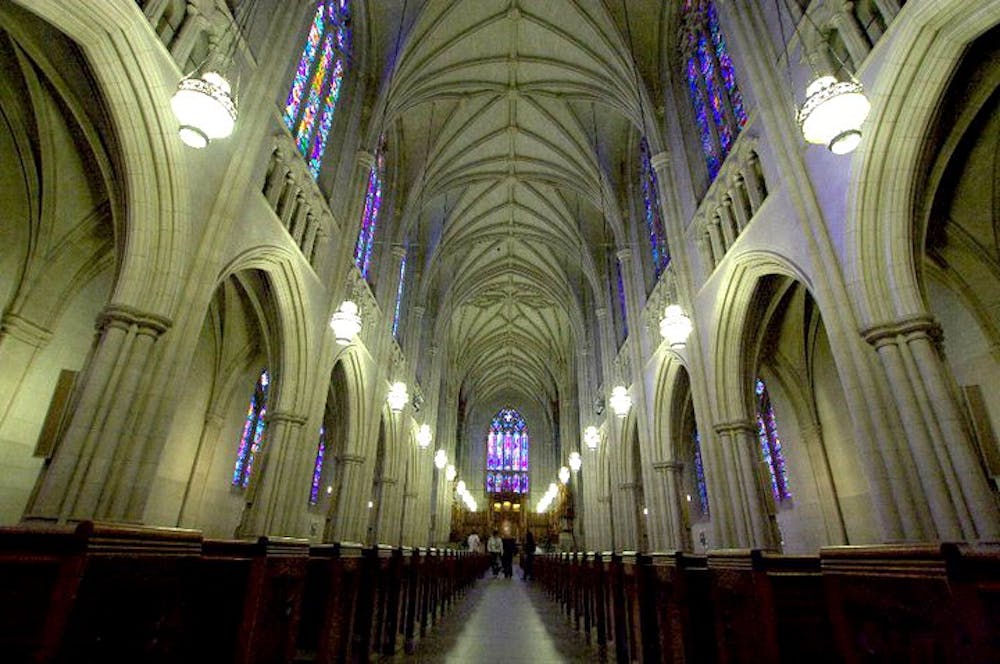The Chapel carillon rang 80 times on the morning of Sept. 11.
It rang 20 times each at 8:46 a.m.—to mark when the first hijacked plane crashed into the World Trade Center’s north tower—9:03 a.m.—to mark when the second plane hit the south tower—9:37 a.m.—when the plane that crashed into the Pentagon in Washington, D.C.—and 10:03 a.m.—for the plane that crashed into a field close to Shanksville, Pa.
As the nation recognized the 20th anniversary of the Sept. 11 terror attacks this past Saturday, Duke Chapel led the campus community in a series of commemorative events to mourn the day’s tragic losses.
The ringing was followed by an interfaith vigil titled “Remember and Hope” on the Chapel steps, led by campus religious leaders, including Luke Powery, associate professor of homiletics and dean of Duke Chapel.
"When we remember the dead, we remember the grief and the loss, but we also remember what is yet to be, we remember our future and try to put our lives back together again. Memory can be difficult and painful, but it is also the space out of which hope rises," Powery said.
Throughout the day of Sept. 11, an exhibition titled “Call and Response, Remembering Prayer, Protest, and Acts of Justice” was held in the Chapel. The exhibit featured information about past vigils and protest movements on Duke’s campus. Visitors received buttons with the word ‘Remember’ on them.
At 7:30 p.m., the Chapel hosted a concert titled “Grant Us Peace” featuring musicians from the Chapel and the Duke Ciompi Quartet.
Events to commemorate 9/11 were held before the date and are planned for the week following the anniversary.
On Sept. 9, the University launched an online, multimedia platform for remembering the day’s events and their impact on the campus community. Titled “20 Years After 9/11: In Remembrance,” the website includes pictures and accounts of gatherings that took place on campus on Sept. 12, 2001, in the wake of the initial attacks. Also featured are faculty testimonials from the attacks’ 15th anniversary in 2016, providing unique insights into the tragedy’s impact on their scholarship.
A Sept. 9 concert by the Chapel’s Choral Vespers echoed the themes of the Sept. 11 commemorations, featuring music that “reminds us of our human frailty” and “unites us with those who have expressed grief and found relief through music.”
Also on Sept. 9, the Triangle Center on Terrorism and Homeland Security hosted writer Wajahat Ali for a discussion of the attacks’ long-term impacts on the U.S. and the world, particularly for Muslims and people of color.
The Congregation at Duke Chapel hosted an online forum for dialogue on Sept. 12 titled “Twenty Years Later: What Has Changed?” The forum featured writer and public speaker Samia Serageldin.
On Sept. 15, the John Hope Franklin Center will host artist Alison Kysia in sharing an art exhibit titled “99 Clay Vessels: The Muslim Women Storytelling Project” meant to bring remembrance to the bigotry experienced by Muslim women in the wake of the Sept. 11 attacks.
On Sept. 17, Kysia will host a related hands-on workshop through DukeCreate.
President Vincent Price addressed the Duke community in a Sept. 10 email, honoring those who lost loved ones in the attacks or served in the military.
“Some members of the Duke community lost family members—including Duke alumni—and others have served with honor in the military in the years since. All of us—no matter how old or where we are from—have had our lives forever changed by the collective trauma of the attacks and their aftermath,” Price wrote.
Six Duke alumni were killed in the Sept. 11 attacks and are commemorated through a plaque near Keohane Quad and several trees planted there on Sept. 11, 2002.
Get The Chronicle straight to your inbox
Signup for our weekly newsletter. Cancel at any time.

Parker Harris is a Trinity senior and an editor at large of The Chronicle's 118th volume.

